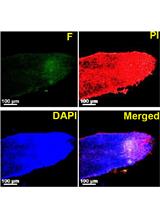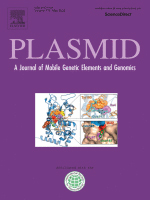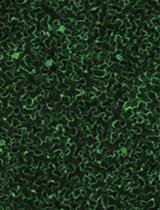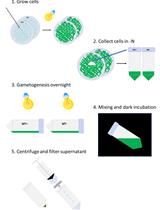- EN - English
- CN - 中文
Faster Bacterial Gene Cloning Using the Brick into the Gateway (BiG) Protocol
使用Brick into the Gateway (BiG) 实验方法快速克隆细菌基因
(*contributed equally to this work) 发布: 2022年12月20日第12卷第24期 DOI: 10.21769/BioProtoc.4576 浏览次数: 2297
评审: Alba BlesaDemosthenis ChronisChangyi Zhang

相关实验方案

各种胁迫条件下根细胞DNA片段化和程序性细胞死亡的TUNEL法评估
Amit K. Tripathi [...] Sneh Lata Singla-Pareek
2017年08月20日 14950 阅读
Abstract
Cloning systems like Gateway and Golden Gate/Braid are known because of their efficiency and accuracy. While the main drawback of Gateway is the expensive cost of the enzymes used in its two-step (LR and BP) reaction, Golden Gate requires non-reusable components due to their specific restriction sites. We present the Brick into the Gateway (BiG) protocol as a new cloning strategy, faster and more economic method that combines (i) reusable modules or bricks assembled by the GoldenBraid approach, and (ii) Gateway LR reactions [recombination of attachment sites: attL (L from left) and attR (R from right)] avoiding the BP reaction [recombination of attachment sites: attP (P from phage) and attB (B from bacteria)] usually necessary in the Gateway cloning. The starting point is to perform a PCR reaction to add type IIS restriction sites into DNA fragments generating specific fusion sites. Then, this PCR product is used to design GoldenBraid bricks, including the attL Gateway recombination sites. Using the Golden Gate method, these bricks are assembled to produce an attL1–gene of interest–attL2 fragment, which is integrated into a compatible vector producing a Gateway entry vector. Finally, the fragment containing the target gene is recombined by LR reaction into the Gateway destination vector.
Graphical abstract

Background
DNA cloning tools have been improved to optimize the efficiency of cloning systems. New cloning methods were designed, such as (i) Gibson assembly, which integrates a number of DNA fragments in a single reaction using a mix of the three enzymes exonuclease, DNA polymerase, and DNA ligase (Gibson et al., 2009), (ii) Gateway, which requires specific recombination sites (atts) in both the DNA fragment and plasmids used in the two reactions steps: BP reaction—in which an entry vector, harboring a DNA fragment flanked by two attL sites, is created; and LR reaction—wherein an expression vector containing a DNA fragment flanked by attB sites is generated (Karimi et al., 2007; Invitrogen, USA); (iii) Golden Gate cloning, a method based on the use of type IIS endonucleases that have cut sites distal from their recognition sites producing overhangs; the complementary overhangs are traditionally ligated by T4 DNA ligase (Engler et al., 2008); (iv) USER cloning (Uracil-Specific Excision Reagent), which employs primers containing uracil to perform PCR reactions; the PCR product is incubated with a commercial deoxyuridine-excision enzyme to eliminate the uracil and generate 3' overhangs that allow the direct cloning of PCR fragments into a USER-compatible vector (Geu-Flores et al., 2007; Hansen et al., 2014); and (v) In-Fusion, in which four or more DNA fragments containing an overlapping of 15 bp at both ends are combined by a reaction equivalent to recombination; the ends overlap is achieved by including the 15 bp in the primers used for DNA amplification (Zhu et al., 2007).
Gateway and Golden Gate are the most used cloning systems. Both have high efficiency and accuracy. However, the drawback of Gateway is the dependency on specific commercial enzymes used for the two clonase reactions, BP and LR, which makes this technique more expensive. On the other hand, Golden Gate requires specific restriction sites in the vector as well as in the DNA fragments, which could be a limiting factor when designing constructs for a large number of genes, as the components of this method are generally not reusable (Marillonnet and Grützner, 2020). Thus, modular assembly systems have been developed to standardize the parts, or bricks (DNA fragments of interest), which is crucial for cloning construction. These modular systems facilitate cloning assembly, making it simpler, more versatile, and autonomous (Patron et al., 2015).
Here, we provide a new cloning method, Brick into the Gateway (BiG), that uses the GoldenBraid/Gate methods to assemble the bricks and the LR reaction from the Gateway system to transfer DNA fragments into any destination vector. Using the GoldenBraid system, we generated standard bricks of the attL sites into an acceptor plasmid pUPD2, which can be combined with other bricks harboring any DNA fragments through a Golden Gate reaction. After this reaction, an entry vector containing the DNA of interest flanked by attL sites is generated, allowing its transfer to a destination vector using Gateway LR clonase. BiG is a low-cost method with a short processing time and directional cloning, whose efficiency was successfully demonstrated (Ferigolo et al., 2022). Most importantly, BiG allows the use of assembled bricks in different studies due to its common syntax (Ferigolo et al., 2022).
Materials and Reagents
Enzymes
High-fidelity DNA polymerase with proper buffer (e.g., platinum SuperFi II polymerase, InvitrogenTM, catalog number: 12361010)
Restriction enzyme cloning BsmBI-v2 with proper buffer (New England Biolabs Inc., catalog number: R0580)
Restriction enzyme cloning BsaI-HFv2 with proper buffer (New England Biolabs Inc., catalog number: R3733)
T4 DNA ligase with proper buffer (e.g., Thermo Fisher ScientificTM, catalog number: EL0014)
Gateway LR clonase II enzyme mix with proper buffer (InvitrogenTM, catalog number: 11791100)
GoTaq green master mix (PromegaTM, catalog number: M7122)
Cloning vectors
Vector harboring attL sites (e.g., pENTRTM/D-TOPOTM)
LM22_attL1 (Addgene, catalog number: 184008)
LM22_attL2 (Addgene, catalog number: 184010)
Universal GoldenBraid acceptor (e.g., pUPD2)
Golden Gate acceptor vector (e.g., pICSL86900OD)
Gateway expression vector of choice
Kits
Gel extraction kit (e.g., QIAEX II, QIAGENTM, catalog number: 20021)
Plasmid Miniprep kit (e.g., GeneJET, Thermo Fisher ScientificTM, catalog number: K0702)
Others
dNTPs, 10 mM (Thermo Fisher ScientificTM, catalog number: R0192)
PCR primers
DNase- and RNase-free water
PCR tubes, 0.2 mL (AxygenTM, catalog number: 14-222-262)
6×loading dye (New England Biolabs Inc., catalog number: B7024S)
1 Kb plus DNA ladder (e.g., InvitrogenTM, catalog number: 10787018)
Agarose 1.5% gel (BioBasic, catalog number: AB0014)
SYBRTM Safe DNA gel stain (InvitrogenTM, catalog number: S33102)
Escherichia coli DH10α chemically competent cells (Thermo Fisher Scientific, catalog number: 18265017)
LB plates with the appropriate antibiotic, IPTG (Fermentas, catalog number: R0392), and X-gal substrate (Fermentas, catalog number: R0401)
Chloramphenicol (Sigma-Aldrich, catalog number: C0378)
Esp31 (Thermo Fisher ScientificTM, catalog number: ER0451)
Eco31I (Thermo Fisher ScientificTM, catalog number: ER0291)
GoldenBraid (GB) reaction (TV = 10 µL) (see Recipes)
LB medium (see Recipes)
Golden Gate reactions (TV = 10 µL) (see Recipes)
LR reaction (TV = 5 µL) (see Recipes)
Equipment
PCR cycler (Mastercycler® nexus, catalog number: 6330000021)
Microwave oven
Gel electrophoresis chamber
Blue-Light transilluminator (Safe ImagerTM 2.0, catalog number: G6600)
NanoDropTM OneC Microvolume UV-Vis spectrophotometer (Thermo Fisher ScientificTM, catalog number: 13-400-519)
Heat block at 42 °C
ColiRollersTM plating beads, Novagen® (Sigma-AldrichTM, catalog number: 71013-3)
Incubators at 37 °C
Software
Benchling R&D Cloud (https://www.benchling.com/)
Procedure
文章信息
版权信息
© 2022 The Authors; exclusive licensee Bio-protocol LLC.
如何引用
Pierdoná, F. G., Carbajal, Y., Vicente, M. H., Ferigolo, L. F. and Nogueira, F. T. S. (2022). Faster Bacterial Gene Cloning Using the Brick into the Gateway (BiG) Protocol. Bio-protocol 12(24): e4576. DOI: 10.21769/BioProtoc.4576.
分类
分子生物学 > DNA > DNA 克隆
植物科学 > 植物分子生物学 > DNA > DNA 修饰
您对这篇实验方法有问题吗?
在此处发布您的问题,我们将邀请本文作者来回答。同时,我们会将您的问题发布到Bio-protocol Exchange,以便寻求社区成员的帮助。
Share
Bluesky
X
Copy link











